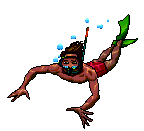Safe Diving Practices...
The following document might seem
like common sense to experienced divers, but it serves as a great guide
for new divers and students alike!
1) Maintain good mental and
physical fitness for diving. Avoid being under the influence of alcohol
or dangerous drugs when diving. Keep proficient in diving skills,
striving to increase them through continuing education and reviewing
them in controlled conditions after a period of diving inactivity.
2)Be familiar with the dive sites,
if not obtain a formal diving orientation from a knowledgeable local
source. If diving conditions are worse than those that have been
experienced, postpone diving to a later date or select an alternate site
with better conditions. Engage only in diving activities consistent with
the training received and experience.
3)Use complete well-maintained
reliable equipment with which you are familiar with, and inspect it for
correct fit and function prior to each dive.
4)Listen carefully to dive
briefings and directions, and respect the advice of those supervising
the dive.
5)Adhere to the buddy system
throughout every dive, plan dives with your buddy and plan the action to
be taken should you be separated. The standard practice is to search
underwater for a minute, after which you surface if you cannot find your
buddy. DO NOT CONTINUE DIVING ALONE.
6)Maintain proper buoyancy, and
breathe properly. Never hold your breath or skip breathe.
Buddy Check procedure
A buddy is a very important
procedure to be ensured before each and every dive. This will make diving
stress free, and prevent any mishaps from occurring. The buddy check
procedure can be easily remembered by the phrase "Begin With Review
And Friend"
B stands for BCD, check that it
is working.
W stands for weights, check for
number of weights, type or belt.
R stands for releases, check all
the clips and buckles and know how they work.
A stands for air, check that the
tank is filled, and that the regulator is working properly.
F stands for a final OK before
taking the plunge.
Gloves anyone?
Under the sea, the marine
life all look strange and exciting to us. We all have this urge to touch
the colourful life below, but sometimes instincts tell us that colourful
marine life and corals might be poisonous. Hence someone went out there
and created the diving glove. An ingenious idea, some might say, but
please be extra careful the next time you put on the glove, and remember
what you have touched underwater.
I once had a friend who
touched everything with his ever so reliable US Diver gloves, corals,
fishes, ferns, even jellyfishes. One fine day he forgot what he touched
underwater, came up, used his gloved hand to wipe his face, and PRESTO!
Jellyfish stings! Apparently he had molested a jellyfish underwater and
the stings has transferred from the jellyfish to is face via the
glove... OUCH...
So the next you wanna touch
something, think twice.
